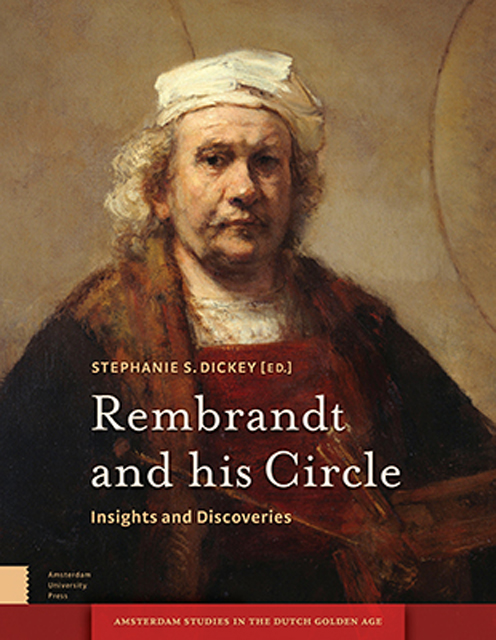Book contents
- Frontmatter
- Dedication
- Contents
- Acknowledgements
- Introduction
- 1 Rembrandt and Frans Hals Painting in the Workshop of Hendrick Uylenburgh
- 2 Rembrandt and the Germanic Style
- 3 Rembrandt and the Humanist Ideal of the Universal Painter
- 4 Curiosity and Desire: Rembrandt’s Collection as Historiographic Barometer
- 5 Painted Landscapes by Lievens and Rembrandt : The View from Seventeenth-Century Amsterdam Collections
- 6 Jan Lievens in Antwerp: Three Rediscovered Works
- 7 Gerrit Dou as a Pupil of Rembrandt
- 8 A New Painting by Jan van Noordt in Budapest
- 9 Rembrandt’s First Nude? The Recent Analysis of Susanna and the Elders from Rembrandt’s Workshop
- 10 Rembrandt’s Head of Christ: Some Technical Observations concerning Matters of Style
- 11 A Rediscovered Head of John the Baptist on a Platter from Rembrandt’s Studio
- 12 Rembrandt’s One Guilder Print: Value and Invention in ‘the most beautiful [print] that ever came from the burin of this Master’
- 13 Rembrandt, Ferdinand Bol, and Tobit: The Emergence of a Pathosträger
- 14 Biblical Iconography in the Graphic Work of Rembrandt’s Circle
- 15 Jan van Vliet and Rembrandt van Rijn: Their Collaboration Reassessed
- 16 Printmaking among Artists of the Rembrandt School
- 17 Chain Line Pattern Matching and Rembrandt’s Prints
- List of Illustrations
- Bibliography
- Index Nominum
1 - Rembrandt and Frans Hals Painting in the Workshop of Hendrick Uylenburgh
Published online by Cambridge University Press: 21 January 2023
- Frontmatter
- Dedication
- Contents
- Acknowledgements
- Introduction
- 1 Rembrandt and Frans Hals Painting in the Workshop of Hendrick Uylenburgh
- 2 Rembrandt and the Germanic Style
- 3 Rembrandt and the Humanist Ideal of the Universal Painter
- 4 Curiosity and Desire: Rembrandt’s Collection as Historiographic Barometer
- 5 Painted Landscapes by Lievens and Rembrandt : The View from Seventeenth-Century Amsterdam Collections
- 6 Jan Lievens in Antwerp: Three Rediscovered Works
- 7 Gerrit Dou as a Pupil of Rembrandt
- 8 A New Painting by Jan van Noordt in Budapest
- 9 Rembrandt’s First Nude? The Recent Analysis of Susanna and the Elders from Rembrandt’s Workshop
- 10 Rembrandt’s Head of Christ: Some Technical Observations concerning Matters of Style
- 11 A Rediscovered Head of John the Baptist on a Platter from Rembrandt’s Studio
- 12 Rembrandt’s One Guilder Print: Value and Invention in ‘the most beautiful [print] that ever came from the burin of this Master’
- 13 Rembrandt, Ferdinand Bol, and Tobit: The Emergence of a Pathosträger
- 14 Biblical Iconography in the Graphic Work of Rembrandt’s Circle
- 15 Jan van Vliet and Rembrandt van Rijn: Their Collaboration Reassessed
- 16 Printmaking among Artists of the Rembrandt School
- 17 Chain Line Pattern Matching and Rembrandt’s Prints
- List of Illustrations
- Bibliography
- Index Nominum
Summary
Abstract
This study combines a compelling array of circumstantial evidence with a fresh look at existing documents to demonstrate that Rembrandt and Frans Hals must have encountered each other in Hendrick Uylenburgh's Amsterdam workshop in 1633. The author identifies a number of portraits painted by Hals in Amsterdam and considers Hals's impact on several of Rembrandt's portraits of the early 1630s, including the magnificent Marten Soolmans and Oopjen Coppit, recently acquired by the Rijksmuseum in partnership with the Musée du Louvre.
Keywords: Rembrandt van Rijn, Frans Hals, Hendrick Uylenburgh, Pieter Codde, Cornelis van der Voort, portraiture, Amsterdam, Haarlem
Buried in a note of my dissertation lies an explosive art historical encounter. The following can be read in the description of The Meagre Company by Frans Hals and Pieter Codde:
The civic guard painting may have been commissioned in 1633 from Hendrik Uylenburgh, who subsequently engaged Frans Hals, just as in 1632 he had approached Rembrandt to execute the Anatomy Lesson of Dr. Tulp. […] Frans Hals stopped coming to Amsterdam after only a few sessions, and following the discontinuation of Uylenburgh's workshop near the lock due to Rembrandt's departure and Uylenburgh's move to a new location, the unfinished militia piece remained behind […]. Pieter Codde, who lived in the neighbourhood, was then charged with finishing the painting. This observation of the two great masters working in the same workshop can now be elaborated upon in greater detail.
Hendrick Uylenburgh in Cornelis van der Voort's Portrait Workshop
Hendrick Uylenburgh established himself in the Sint Anthonisbreestraat (at the corner of the lock, or 2 Jodenbreestraat) in the former workshop of the portraitist Cornelis van der Voort around 1625. The property at the corner of the lock and the ‘Rembrandt House’ next door on the main street (Breestraat, or Broad Street), built during the first modern Amsterdam city expansion, were precursors of the later merchant houses along the prestigious Herengracht and Keizersgracht in the canal district. Their appeal lay in the luxurious layout with high ceilings and large windows, which allowed for more light and space than was found in the mediaeval houses of the ancient city centre.
- Type
- Chapter
- Information
- Rembrandt and his CircleInsights and Discoveries, pp. 17 - 43Publisher: Amsterdam University PressPrint publication year: 2017



